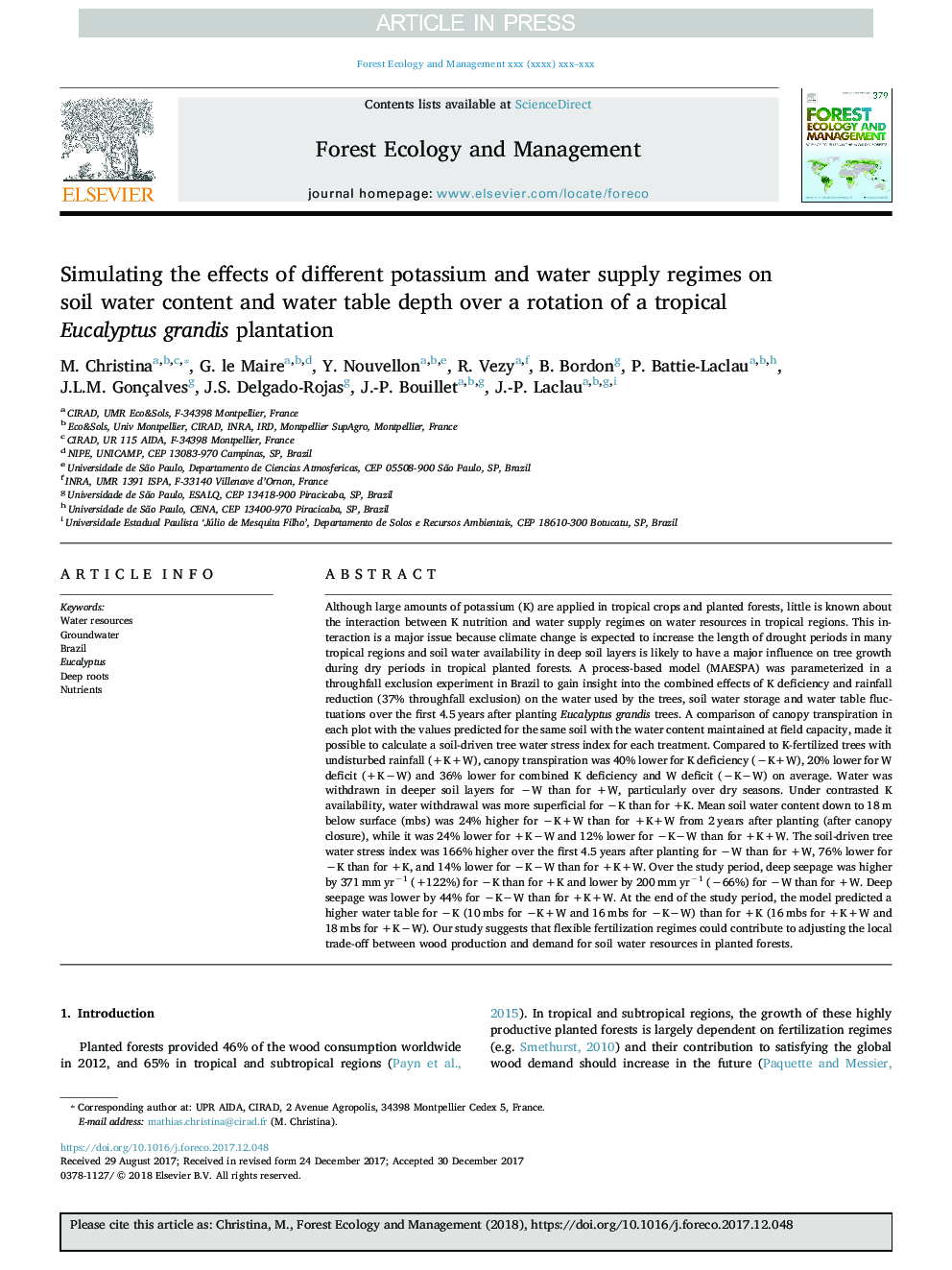| کد مقاله | کد نشریه | سال انتشار | مقاله انگلیسی | نسخه تمام متن |
|---|---|---|---|---|
| 6541725 | 1421341 | 2018 | 11 صفحه PDF | دانلود رایگان |
عنوان انگلیسی مقاله ISI
Simulating the effects of different potassium and water supply regimes on soil water content and water table depth over a rotation of a tropical Eucalyptus grandis plantation
ترجمه فارسی عنوان
شبیه سازی اثرات رژیم های مختلف پتاسیم و آب بر میزان آب خاک و عمق آب در طی چرخش یک گیاه اکالیپتوس گراندی گرمسیری
دانلود مقاله + سفارش ترجمه
دانلود مقاله ISI انگلیسی
رایگان برای ایرانیان
کلمات کلیدی
منابع آبی، آب های زیرزمینی، برزیل، اکالیپتوس، ریشه های عمیق، مواد مغذی
موضوعات مرتبط
علوم زیستی و بیوفناوری
علوم کشاورزی و بیولوژیک
بوم شناسی، تکامل، رفتار و سامانه شناسی
چکیده انگلیسی
Although large amounts of potassium (K) are applied in tropical crops and planted forests, little is known about the interaction between K nutrition and water supply regimes on water resources in tropical regions. This interaction is a major issue because climate change is expected to increase the length of drought periods in many tropical regions and soil water availability in deep soil layers is likely to have a major influence on tree growth during dry periods in tropical planted forests. A process-based model (MAESPA) was parameterized in a throughfall exclusion experiment in Brazil to gain insight into the combined effects of K deficiency and rainfall reduction (37% throughfall exclusion) on the water used by the trees, soil water storage and water table fluctuations over the first 4.5â¯years after planting Eucalyptus grandis trees. A comparison of canopy transpiration in each plot with the values predicted for the same soil with the water content maintained at field capacity, made it possible to calculate a soil-driven tree water stress index for each treatment. Compared to K-fertilized trees with undisturbed rainfall (+K+W), canopy transpiration was 40% lower for K deficiency (âK+W), 20% lower for W deficit (+KâW) and 36% lower for combined K deficiency and W deficit (âKâW) on average. Water was withdrawn in deeper soil layers for âW than for +W, particularly over dry seasons. Under contrasted K availability, water withdrawal was more superficial for âK than for +K. Mean soil water content down to 18â¯m below surface (mbs) was 24% higher for âK+W than for +K+W from 2â¯years after planting (after canopy closure), while it was 24% lower for +KâW and 12% lower for âKâW than for +K+W. The soil-driven tree water stress index was 166% higher over the first 4.5â¯years after planting for âW than for +W, 76% lower for âK than for +K, and 14% lower for âKâW than for +K+W. Over the study period, deep seepage was higher by 371â¯mmâ¯yrâ1 (+122%) for âK than for +K and lower by 200â¯mmâ¯yrâ1 (â66%) for âW than for +W. Deep seepage was lower by 44% for âKâW than for +K+W. At the end of the study period, the model predicted a higher water table for âK (10â¯mbs for âK+W and 16â¯mbs for âKâW) than for +K (16â¯mbs for +K+W and 18â¯mbs for +KâW). Our study suggests that flexible fertilization regimes could contribute to adjusting the local trade-off between wood production and demand for soil water resources in planted forests.
ناشر
Database: Elsevier - ScienceDirect (ساینس دایرکت)
Journal: Forest Ecology and Management - Volume 418, 1 June 2018, Pages 4-14
Journal: Forest Ecology and Management - Volume 418, 1 June 2018, Pages 4-14
نویسندگان
M. Christina, G. le Maire, Y. Nouvellon, R. Vezy, B. Bordon, P. Battie-Laclau, J.L.M. Gonçalves, J.S. Delgado-Rojas, J.-P. Bouillet, J.-P. Laclau,
